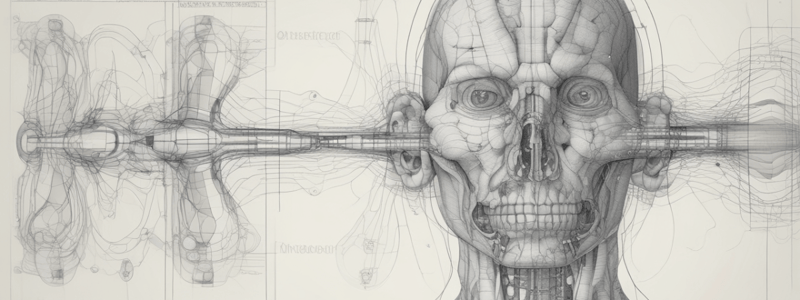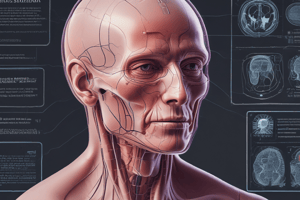Podcast
Questions and Answers
What is the main purpose of A-mode in ultrasound imaging?
What is the main purpose of A-mode in ultrasound imaging?
In A-mode, what is the depth of an interface proportional to?
In A-mode, what is the depth of an interface proportional to?
What is the average sound velocity used in soft tissue for A-mode calculations?
What is the average sound velocity used in soft tissue for A-mode calculations?
What application is related to A-mode in detecting brain tumors?
What application is related to A-mode in detecting brain tumors?
Signup and view all the answers
What is considered abnormal for a shift in the middle structure using Echo encephalography in adults?
What is considered abnormal for a shift in the middle structure using Echo encephalography in adults?
Signup and view all the answers
In the field of ophthalmology, what is not measured using A-mode biometry?
In the field of ophthalmology, what is not measured using A-mode biometry?
Signup and view all the answers
Why do higher ultrasound frequencies up to 20 MHz provide better resolution in eye examinations?
Why do higher ultrasound frequencies up to 20 MHz provide better resolution in eye examinations?
Signup and view all the answers
Which ultrasound mode is used to obtain 2D images of the body?
Which ultrasound mode is used to obtain 2D images of the body?
Signup and view all the answers
What distinguishes B-mode from A-mode in ultrasound imaging?
What distinguishes B-mode from A-mode in ultrasound imaging?
Signup and view all the answers
Which of the following structures is not directly examined using B-mode ultrasound?
Which of the following structures is not directly examined using B-mode ultrasound?
Signup and view all the answers
Study Notes
US Image Modes
A-Mode (1D)
- Used to obtain diagnostic information about the depth of structures (image with 1 dimension)
- US waves sent into the body, measuring time required to receive reflected sound (echoes) from interfaces between different tissues
- Depth of interface recorded is proportional to time it takes for echo to return: Depth = Velocity × time
- In average soft tissue, sound velocity is 1540 m/sec, and echo takes 13 µsec at a depth of 1 cm
- Applications: detection of brain tumors and eye diseases
Applications of A-Mode Scan
Echo Encephalography
- Used to detect brain tumors
- Pulses of ultrasound sent to a thin region of the skull above the ear
- Echoes from different structures displayed on oscilloscope
- Compare echoes from left and right sides of head to find shift in middle structure:
- Shift > 3 mm for an adult (abnormal)
- Shift > 2 mm for a child (abnormal)
Ophthalmology
- Used in diagnosis of eye diseases and biometry (measuring distances in the eye)
- Ultrasound frequencies up to 20 MHz used for better resolution and minimal absorption
US Image Modes
B-Mode (2D)
- Used to obtain 2D images of the body
- Principle same as A-Mode, but transducer moves, and storage oscilloscope forms the image
- Provides information about internal structures of the body (size, location, and change over time)
Studying That Suits You
Use AI to generate personalized quizzes and flashcards to suit your learning preferences.
Description
Learn about different modes of ultrasound imaging, including A-Mode, used to obtain diagnostic information about the depth of structures in the body. Understand how it works and its applications.




